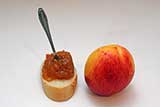Meats and Sausages
Peach Jam
The flavor of peach jam may be varied by keeping some of the pits. Pits of fruits such as apricots, peaches or sour cherries introduce a hint of almond flavor. In peaches, the pits are large and not easy to crack, however, the task becomes easier after they are baked first. Then, the inside core of the pit is baked and added to jams. The pits of the above mentioned fruits contain traces of cyanide (cyanide produces almond smell). This heat treatment takes care of any allergic reaction.
- Peaches, 1.2 kg (2.65 lb)
- Sugar, 400 g (0.88 lb)
- Lemon juice, 100 ml (3.4 oz fl)
- ½ pint jars
- Split open peaches, save 6 pits, discard the rest. Slice peaches and place in a large bowl. Add sugar, mix, cover and leave for 4 hours at room temperature.
- Bake pits for 15 minutes on a cookie sheet at 356° F (180° C), remove from the oven, but maintain the heat. Crack shells open, remove inside cores and bake them again for 5 minutes at above temperature.
- Place peaches in a large pot, add lemon juice, and bring to a boil over medium heat.
- Continue cooking for about 15 minutes, stirring often, until jam thickens. Do not cover, the purpose of cooking is to evaporate water.
- Place one or two pits in each jar, then fill with jam to within ¼ inch from the top. Remove air bubbles, install and tighten covers.
- Place jars in a bath canner and bring water to boil. Cook for 10 minutes.
- Remove jars from the canner and leave undisturbed for 12 hours.
- Store in cool and dark place.


















